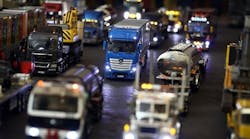Researchers have found a way of determining how much traffic congestion contributes to logistics costs in hard dollars-and-cents numbers. That’s the good news. The bad news is that they say congestion will only get worse. There is not much that can be done about it in the short term, and it will take smart policies, technology and leadership to overcome in the long term.
The 2105 Urban Mobility Report, which was published recently by the Texas Transportation Institute (TTI), of Texas A&M University covers all of this and more.
"No single approach will ever solve this complex problem," says Tim Lomax, a report author and Regents Fellow at TTI. “We know what works. What the country needs is a robust, information-powered conversation at the local, state and national levels about what steps should be taken. We have many strategies; we have to figure out the right solution for each problem and a way to pay for them.”
Marc Williams, deputy executive director of the Texas Department of Transportation, which funded the TTI research, says, “The value of investing in our nation’s transportation infrastructure in a strategic and effective manner cannot be overstated as these added costs impact our national productivity, quality of life, economic efficiency and global competitiveness.”
In 2017, congestion caused urban Americans to travel an extra 8.8 billion hours and purchase an extra 3.3 billion gallons of fuel for a congestion cost of $166 billion. Measured together, those two costs alone were up from a total of $157 billion in 2016, $71 billion in 2000 and $14 billion in 1982 – all measured in constant 2017 dollars.
“The problem affects not only commuters but also manufacturers and shippers whose travel delay costs are passed on to consumers,” says Bill Eisele, a report author and TTI senior research engineer. “While trucks constitute only 7% of road traffic, they account for 12% of congestion cost.”
These logistics costs do not include the extra costs borne by companies for building additional distribution centers, buying more trucks and building more satellite distribution centers to allow them to overcome the problems caused by a congested and inefficient transportation network.
Congestion has gotten so bad that it is a problem at all times of day, not just the usual “rush” hours. The researchers found that about 33% of total delay occurs in the midday and overnight, the times of day when travelers and shippers would normally expect free-flow travel.
In addition, congestion has gotten worse in areas of every size – it’s not just a big city problem. “Big towns and small cities have congestion problems,” the researchers note. “Every economy is different and smaller regions often count on good mobility as a quality-of-life aspect that allows them to compete with larger, more economically diverse regions.”
David Schrank, a TTI senior research scientist and report author, adds, “Eventually, we’re talking billions of wasted hours, and the cost of delay at that scale is just enormous. Simply put, travel demand is growing faster than the system’s ability to absorb that demand. Once considered a problem exclusive to big cities, roadway gridlock now afflicts urban areas of all sizes and consumes far more of each day, making ‘rush hour’ a long-outdated reference.”
Breaking Down the Costs
Take the example of a trip that typically requires 20 minutes of driving when there are few other vehicles on the road. In 2017, the average big city commute was 26 minutes in the morning and 28 minutes in the evening peak, the researchers point out
If you must make a very important trip during any of these time periods, there is additional
“planning time” you must allow to reliably arrive on-time. Your 20-minute trip means you should plan for around 33 minutes in the morning and 36 minutes in the evening, and even 30 minutes in the midday.
This is not just a “big city rush hour” problem, either. The planning time averages 24 minutes in the morning and 26 minutes in the evening for the smaller regions. If that isn't bad enough, travelers and freight shoppers had to add nearly 70% more travel time compared with light traffic conditions to account for the effects of unexpected crashes, bad weather, special events and other irregular congestion causes.
The TTI report also finds:
• Approximately 54% of travel delays in large regions take place on freeways.
• Streets have more delay than freeways in smaller regions, but there are also many more miles of streets.
• About 30% of delays occur in off-peak hours in big regions. That value rises to 40% in smaller regions.
• Freeway congestion is much less of the problem in areas under one million population – about one-third of medium and small region delays are on freeways.
How bad will congestion get in the future? The researchers think they have a good idea about what we will need to deal with.
• The national congestion cost will grow from $166 billion in 2017 to $200 billion in 2025 (in 2017 dollars) -- a 20% increase/
• Delays will worsen to 10 billion hours in 2025 -- a 14% increase.
• Wasted fuel will rise to 3.6 billion gallons in 2025 -- a 9% increase.
• The average commuter’s congestion cost will grow from $1,010 in 2017 to $1,140 in 2025 (in 2017 dollars) -- a 13% increase.
• The average commuter will waste 62 hours (almost eight vacation days) and 23 gallons of fuel in 2025 -- a 15% increase in wasted time.
"Congestion is back to its growth pattern. The 8 to the 10-year growing economy has brought traffic.
congestion to the highest measured levels in most U.S. cities, says Bill Eisele, a report author and TTI senior research engineer. "the myriad possible solutions -- from more highways, streets and public transportation, better traffic operations, more travel options, new land development styles, advanced technology -- have not worked."
Will Anything Help?
Although congestion will surely get worse, the TTI researchers stress it is vital to act not to develop the consensus on action steps for the major projects, programs and funding efforts that take 10 to 15 years to develop. “We recommend a balanced and diversified approach to reduce congestion – one that focuses on more of everything; more policies, programs, projects, flexibility, options and understanding,” they say.
What is the right kind of solution to a specific congestion problem? According to the researchers, the answer depends entirely on context. “Almost every solution strategy works somewhere in some situation. And almost every strategy is the wrong treatment in some places and times. Anyone who tells you there is a single solution that can solve congestion, be supported and implemented everywhere (or even in most locations) is exaggerating the effect of their idea.”
Some cities see growth taking place near downtowns that provide good home and work options, but which rarely dominate the regional growth trends. Governments have been streamlining regulations to make near-town development as easy to do as suburban developments. Geographic strategies also include encouraging development of mixed-use suburban “town centers” where people can live nearer where they work and go to school.
Another approach: Get as much as possible from what we have by getting the best bang for the buck. Many low-cost improvements have broad public support and can be rapidly deployed, the researchers explain. These include rapidly removing crashed vehicles, timing the traffic signals so that more vehicles see green lights, and improving road and intersection designs.
More complex changes involve traffic signals that rapidly adapt to different traffic patterns, and systems that smooth traffic flow and reduce traffic collisions, and communication technologies that connect drivers and the transportation network. Among these are connected vehicles that are capable of “talking” to each other, traffic signals and other systems while supplying decision-makers with this information to identify and fix mobility problems.
These options allow travelers and shippers to make trips when, where and in a form that best suits their needs and wants, the researchers. Many current sources of travel information can display existing travel times, locations of roadwork or crashes, transit ridership and arrival information while offering a variety of trip planner resources.
Newer model vehicles sense and adjust to their surroundings, increasing safety and efficient movement of goods and people. The researchers also predict that advancements in autonomous vehicles will reduce crashes and congestion when they become widely adopted in the future.
To alleviate commuting, employers also can help by adopting flexible work hours, allowing employees to choose work schedules that meet family needs and job requirements. Companies are reported to have enjoyed productivity increase when workers are able to adjust their travel schedules.
The obvious solution is the oldest: add capacity in critical corridors, such as building more street and highway lanes. But those projects take the longest to plan and bring to conclusion., Don’t expect any of these things to alleviate congestion in the near term, the TTI researchers warn.
“Realistic expectations are also part of the solution,” they add. “Large urban areas will be congested. Some locations near key activity centers in smaller urban areas also will be congested. Identifying solutions and funding sources that meet a variety of community goals is challenging enough without attempting to eliminate congestion in all locations at all times.”
In spite of this fact, TTI offers that by taking the right steps, we can make sure that congestion does not have to be an all-day event. “In many cases improving travel time awareness and predictability can be a positive first step towards improving urban mobility.”




